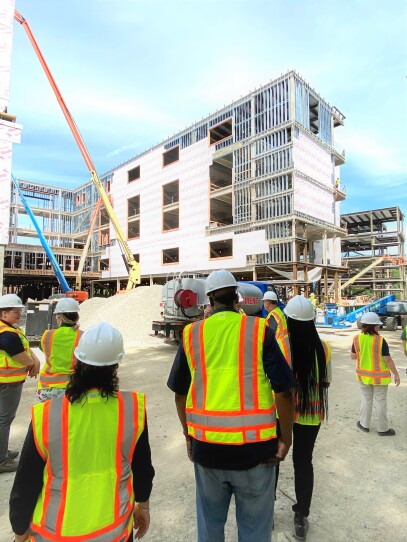Bill Aalerud says he is part of the problem.
“I’m exactly what we're trying to change,” said the 65-year-old vice president of the North Reading construction firm Columbia. “I'm your typical white guy who helps run these [construction] organizations — and you look at each and every one of them, we're all the same. So we need to change this.”
To help drive that change, the Associated General Contractors of Massachusetts, an association of about 200 construction companies, convened 15 educators from around the state Monday morning to launch a weeklong intensive introduction to the construction trades. The group wil be visiting construction firms around the state and learning about the wide variety of skills and trades that are needed for constuction projects, ranging from computer assisted design to bricklaying to marketing and communications. The idea is that each of the participating educators will be able to go back to their school districts as ambassadors to pitch students on the field.
The goal is partly to diversify the construction trades — but it is also simply to get more bodies on the job, as there is a vast shortage of construction workers in Massachusetts and nationwide, even as federal and state governments are pouring hundreds of billions of dollars into new infrastructure construction.
“The number-one challenge in the construction industry across the country right now is the workforce shortage,” said Aalerud, who also serves as chairman of the AGC board of directors. “We can't find enough people either in the trades or in the professional roles to work at the offices to handle all the work that this industry has been asked to build.”
Nationally, there are more than 370,000 construction jobs unfilled, he said.
More Local News
The national AGC issued a workforce survey last year that found around 85-90% of construction firms were having trouble finding qualified workers to fill jobs. “Workforce shortages are severe and having a significant impact on construction firms,” the group declared. “These impacts, including longer construction schedules, are affecting the broader economy and have the potential to undermine the economic recovery.”
As GBH News has reported, the building trades in Boston have remained heavily dominated by white men, even as the Boston-area population has diversified.
Segun Idowu, Boston’s chief of Economic Opportunity and Inclusion, told GBH News last month “there just aren’t enough people for all of the important work that that’s coming down and that we have to do here, not only in Boston but the entire commonwealth.” He said the city is trying to expand outreach and education about opportunities in the building trades because “what sometimes blocks people from advancing is just not knowing — and we’re happy to walk them along the path.”
AGC is not alone in trying to expose the TikTok generation to a possible future in construction. Suffolk Construction hosted 22 Girl Scouts at its Boston headquarters earlier this month for a daylong introduction to construction and to women who have made careers in the field. The field trip was part of the company’s “Rebuild the Ratio” partnership launched last year with the Girl Scouts of Eastern Massachusetts, which included a pledge by Suffolk to create a “Construction 101” curriculum targeted specifically at girls aged 5-17.
On Monday morning, about a dozen educators toured the construction of Worcester’s new Doherty Memorial High School, being built by Fontaine Brothers and Dimeo Construction.
Tiye Cort Odima, a teacher at a private school in Providence, R.I., joined the tour.
“I feel like that’s my role to sort of guide [students] in the right direction, depending on their interest,” she said. “And so when I heard about this, it was a great opportunity to really get to know a little bit more about a field that I would be introducing students to.”

Kevin McCaskill, assistant superintendent of Office of Secondary Schools for Boston Public Schools, added his goal is to increase exposure for students as far down as middle school to the range of career possibilities in construction.
“There are just a multitude of opportunities — and beyond the obvious hands-on opportunities you may see in carpentry or HVAC or electrical,” he said. “There are other aspects of the construction field that deal with technology graphic communication, graphic design, marketing, accounting. There are so many fields to this and that everyone can be an active participant in it.”
U.S. Rep. Jim McGovern also joined the tour of the construction site, noting that two of his sisters were Worcester schoolteachers. “The challenge is always, you know: what happens when you get out of school?” he said. “And how do you introduce young people to these new careers, especially in the construction industry, where you can make a decent living ... and how do you prepare to be able to enter into this workforce?”
John Ferrante, the CEO of the Massachusetts contractors' group, said the push to grow the construction workforce will also diversify the workforce. "Let's just find whoever's willing to work with us and really put in the effort," he said. "Hopefully we can achieve the results that we're looking for. And that begins by inspiring those populations who may not see a place for themselves in the industry and saying, 'No, there is a place for everybody.'"








